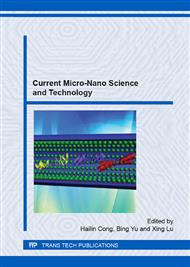[1]
T. Kai, I. Taniguchi, S. Duan, F.A. Chowdhury, T. Saito, K. Yamazaki, K. Ikeda, T. Ohara, S. Asano, S. Kazama, Molecular Gate Membrane: Poly(amidoamine) Dendrimer/polymer Hybrid Membrane Modules for CO2 Capture, Energy Procedia 37(2013)961-968.
DOI: 10.1016/j.egypro.2013.05.191
Google Scholar
[2]
S. Duan, I. Taniguchi, T. Kai, S. Kazama. Development of poly(amidoamine) dendrimer/polyvinyl alcohol hybrid membranes for CO2 capture at elevated Pressures, Energy Procedia 37(2013)924-931.
DOI: 10.1016/j.egypro.2013.05.187
Google Scholar
[3]
T.V. Gestel, D. Sebold, F. Hauler, W.A. Meulenberg, H.P. Buchkremer, Potentialities of microporous membranes for H2/CO2 separation in future fossil fuel power plants: Evaluation of SiO2, ZrO2, Y2O3-ZrO2 and TiO2-ZrO2 sol-gel membranes, J. Membr. Sci. 359(2010).
DOI: 10.1016/j.memsci.2010.04.002
Google Scholar
[4]
A. Huang, Y. Chen, Q. Liu, N. Wang, J. Jiang, J. Caro, Synthesis of highly hydrophobic and permselective metal-organic framework Zn(BDC)(TED)0. 5 membranes for H2/CO2 separation, J. Membr. Sci. 454(2014)126-132.
DOI: 10.1016/j.memsci.2013.12.018
Google Scholar
[5]
S. Nayebossadri, J. Speight, D. Book, Effects of low Ag additions on the hydrogen permeability of Pd-Cu-Ag hydrogen separation membranes, J. Membr. Sci. 451(2014)216-225.
DOI: 10.1016/j.memsci.2013.10.002
Google Scholar
[6]
A.E. Lewis, H. Zhao, H. Syed, C.A. Wolden, J.D. Way, PdAu and PdAuAg composite membranes for hydrogen separation from synthetic water-gas shift streams containing hydrogen sulfide. J. Membr. Sci. 465(2014)167-176.
DOI: 10.1016/j.memsci.2014.04.022
Google Scholar
[7]
G. Manzolini, M. Gazzani, D.M. Turi, E. Macchi, Application of hydrogen selective membranes to IGCC, Energy Procedia 37(2013)2274-2283.
DOI: 10.1016/j.egypro.2013.06.108
Google Scholar
[8]
A.E. Lewis, D.C. Kershner, S.N. Paglieri, M.J. Slepicka, J.D. Way, Pd-Pt/YSZ composite membranes for hydrogen separation from synthetic water–gas shift streams. J. Membr. Sci. 437(2013)257-264.
DOI: 10.1016/j.memsci.2013.02.056
Google Scholar
[9]
Q. Wei, Y.L. Ding, Z.R. Nie, X.G. Liu, Q.Y. Li, Wettability, pore structure and performance of perfluorodecyl-modified silica membranes. J. Membr. Sci. 466(2014)114-122.
DOI: 10.1016/j.memsci.2014.04.036
Google Scholar
[10]
B. Yu, H. Cong, X. Zhao, Hybrid brominated sulfonated poly(2, 6-diphenyl-1, 4-phenyleneoxide) and SiO2 nanocomposite membranes for CO2/N2 separation, Progress in Natural Science: Materials International 22(2012)661-667.
DOI: 10.1016/j.pnsc.2012.11.004
Google Scholar
[11]
J.H. Ryu, D.S. Chang, B.G. Choi, J.W. Yoon, C.S. Lim, K.B. Shim, Fabrication of Ag nanoparticles-coated macroporous SiO2 structure by using polystyrene spheres. Mater. Chem. Phys. 2-3(2007) 486-491.
DOI: 10.1016/j.matchemphys.2006.08.010
Google Scholar
[12]
S.D. Bhagat, Y.H. Kim, Y.S. Ahn, Room temperature synthesis of water repellent silica coatings by the dip coat technique, Appl. Surf. Sci. 253 (2006)2217-2221.
DOI: 10.1016/j.apsusc.2006.04.030
Google Scholar
[13]
Z. Zhang, Y. Tanigami, R. Terai, H. Wakabayashi, Preparation of transparent methyl-modified silica gel, J. Non-Cryst. Solids 189 (1995)212-217.
DOI: 10.1016/0022-3093(95)00209-x
Google Scholar
[14]
S. Lee, Y.C. Cha, H.J. Hwang, J.W. Moon, I.S. Han, The effect of pH on the physicochemical properties of silica aerogels prepared by an ambient pressure drying method, Mater. Lett. 61 (2007)3130-3133.
DOI: 10.1016/j.matlet.2006.11.010
Google Scholar
[15]
H.M. Jiang, Z. Zheng, X.L. Wang, Kinetic study of methyltriethoxysilane (MTES) hydrolysis by FTIR spectroscopy under different temperatures and solvents, Vib. Spectrosc. 46 (2008)1-7.
DOI: 10.1016/j.vibspec.2007.07.002
Google Scholar
[16]
J. Yang, J.R. Chen, Surface free energies and steam stability of methyl-modified silica membranes, J. Porous. Mater. 16 (2009)737-744.
DOI: 10.1007/s10934-008-9256-1
Google Scholar


